-
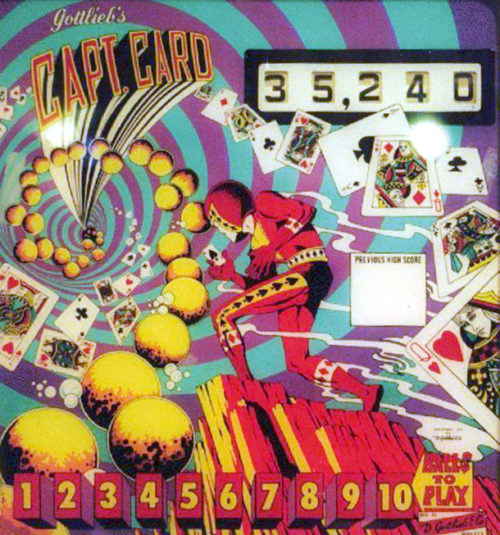 May was the release month for this game. Designer Ed Krynski and artist Gordon Morison put together the package. Production run was low, at 675 units. This is an add-a-ball game variant, the replay version was called High Hand. The challenging part of this playfield design is trying to lock a ball in the eject hole for extra balls. Four batteries of drop targets in four colors are along the sides of the playfield. Making a completion of a color of drop targets increases the value of the eject and side drains. If all the drop targets are completed, the extra ball features light up. Score is another way to win balls set by the operator. No match units were incorporated into these games as, again, that was considered a form of gambling, i.e. winning a free game.
May was the release month for this game. Designer Ed Krynski and artist Gordon Morison put together the package. Production run was low, at 675 units. This is an add-a-ball game variant, the replay version was called High Hand. The challenging part of this playfield design is trying to lock a ball in the eject hole for extra balls. Four batteries of drop targets in four colors are along the sides of the playfield. Making a completion of a color of drop targets increases the value of the eject and side drains. If all the drop targets are completed, the extra ball features light up. Score is another way to win balls set by the operator. No match units were incorporated into these games as, again, that was considered a form of gambling, i.e. winning a free game. -
 This game was developed with the Beatles craze of the day in mind, as you can see the caricatures of the Fab Four incorporated into the art of the machine. The production run of this two-player game was 2,802 units. Designed by the legendary Steve Kordek with art by Jerry Kelley, the object of the game is to complete all four quadrants of the clock image by hitting the 3,6,9 and 12 quadrants. Doing so advances the bonus system of scoring, lights extra ball features and one special feature. An interesting part of the game design was the stepped target in the middle of the play field. Hitting this target would score the target value currently displayed and the target advances 90 degrees to the next target. Each new ball resets the clock to zero completed parts. The operator had the ability to adjust the points needed for free games, the number of score levels, if a special awarded a free game or an extra ball, and the option of three- or five-ball play.
This game was developed with the Beatles craze of the day in mind, as you can see the caricatures of the Fab Four incorporated into the art of the machine. The production run of this two-player game was 2,802 units. Designed by the legendary Steve Kordek with art by Jerry Kelley, the object of the game is to complete all four quadrants of the clock image by hitting the 3,6,9 and 12 quadrants. Doing so advances the bonus system of scoring, lights extra ball features and one special feature. An interesting part of the game design was the stepped target in the middle of the play field. Hitting this target would score the target value currently displayed and the target advances 90 degrees to the next target. Each new ball resets the clock to zero completed parts. The operator had the ability to adjust the points needed for free games, the number of score levels, if a special awarded a free game or an extra ball, and the option of three- or five-ball play. -
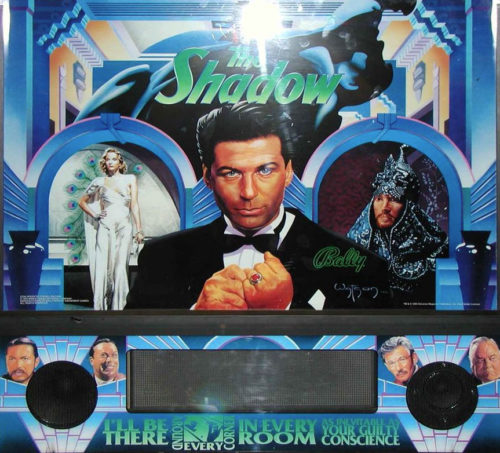 This machine is based on the ’30s radio series then turned into a movie. Design accolades go to Brian Eddy with art scripted by Doug Watson. 4,247 of these machines were made. The interesting feature in this machine is the elevated upper-left playfield. This playfield is gained access to once the drop target is hit. Once this challenge is complete, another shot to this ramp shoots the ball upstairs to this feature. Pressing the flipper buttons moves the paddle left or right. The kicker is activated by an optic sensor automatically to hit all the targets if your aim is sure. This game also has a thrust magnet which grabs the ball in action and shoots it up the playfield into the next feature. No pop bumpers are on the playfield, which is a rare event. Another first incorporated into this playfield are two ramp diverters which are player adjustable. Completing the six scenes of the story award you with the final battle sequence of good against evil.
This machine is based on the ’30s radio series then turned into a movie. Design accolades go to Brian Eddy with art scripted by Doug Watson. 4,247 of these machines were made. The interesting feature in this machine is the elevated upper-left playfield. This playfield is gained access to once the drop target is hit. Once this challenge is complete, another shot to this ramp shoots the ball upstairs to this feature. Pressing the flipper buttons moves the paddle left or right. The kicker is activated by an optic sensor automatically to hit all the targets if your aim is sure. This game also has a thrust magnet which grabs the ball in action and shoots it up the playfield into the next feature. No pop bumpers are on the playfield, which is a rare event. Another first incorporated into this playfield are two ramp diverters which are player adjustable. Completing the six scenes of the story award you with the final battle sequence of good against evil. -
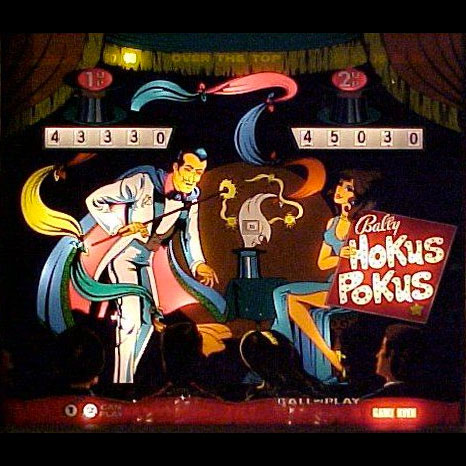
-
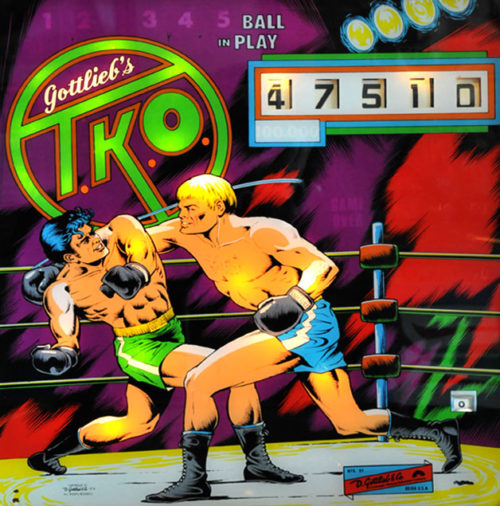 Look no further! If you’re searching for the rarest of the rare, here for your perusal is not one but two examples of this Gottlieb aberration. Supposedly only 125 were made of this game and most were sold overseas. Ed Krynski and Gordon Morison again teamed up to art and design the game. This game represents one of the last electromechanical “wedgehead” games ever built near the shores of Lake Michigan. It’s also a single-player game and one of the last. The object of the game is not really boxing in the true sense but hitting enough targets to advance the central advance display up to the top of the rack. This will ignite the special lights for a free game. The color-coordinated advance inserts on the play field correspond to the light-up features on the play field and, if you advance the light sequence accordingly, those features light up for the brief time the advance mechanism stays on that light. Score is the easiest way to win a replay.
Look no further! If you’re searching for the rarest of the rare, here for your perusal is not one but two examples of this Gottlieb aberration. Supposedly only 125 were made of this game and most were sold overseas. Ed Krynski and Gordon Morison again teamed up to art and design the game. This game represents one of the last electromechanical “wedgehead” games ever built near the shores of Lake Michigan. It’s also a single-player game and one of the last. The object of the game is not really boxing in the true sense but hitting enough targets to advance the central advance display up to the top of the rack. This will ignite the special lights for a free game. The color-coordinated advance inserts on the play field correspond to the light-up features on the play field and, if you advance the light sequence accordingly, those features light up for the brief time the advance mechanism stays on that light. Score is the easiest way to win a replay. -
 This Norm Clark and Christian Marsche creation was also produced in an add-a-ball version called Love Bug as well as a four-player version called Dipsy Doodle. This symmetrical playfield design has a captive ball under the playfield which, when activated, rolls over a switch to score a bonus batch of points based on the value of the button when the feature is lit. The top kickout hole randomly selects bonus features to make the game more intriguing. A popup post between the flippers prevents ball drain down the middle of the playfield, but this post may be retracted just at the wrong time if the down-post targets are hit. An extra ball may be achieved if the center target is lit. This target also activates the “doodlebug” under the playfield. Finally, a free ball gate is incorporated into the machine if the appropriate combination of pop bumpers and rollovers are made. A fast-paced game that was popular in its day.
This Norm Clark and Christian Marsche creation was also produced in an add-a-ball version called Love Bug as well as a four-player version called Dipsy Doodle. This symmetrical playfield design has a captive ball under the playfield which, when activated, rolls over a switch to score a bonus batch of points based on the value of the button when the feature is lit. The top kickout hole randomly selects bonus features to make the game more intriguing. A popup post between the flippers prevents ball drain down the middle of the playfield, but this post may be retracted just at the wrong time if the down-post targets are hit. An extra ball may be achieved if the center target is lit. This target also activates the “doodlebug” under the playfield. Finally, a free ball gate is incorporated into the machine if the appropriate combination of pop bumpers and rollovers are made. A fast-paced game that was popular in its day. -
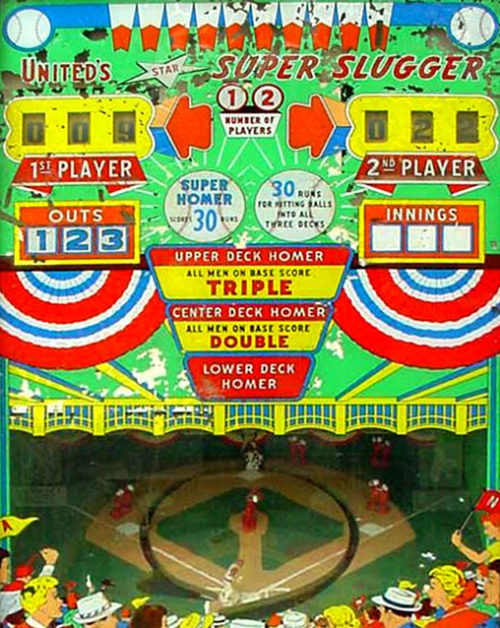 This massive baseball “pitch and bat” game is considered one of the best baseball games of its era. One or two players could play this behemoth at once, with each player alternating for three innings of play for a nickel or dime. The pitcher may randomly press one of three pitch buttons to pick a weak-to-strong pitch to the batter. The open play field allows one to try and score a home run in one of three bleachers. If you can achieve getting a homer in all three bleachers during your three outs, 30 extra runs are awarded. Then, of course, the ultimate tag of the ball would land the ball in the super home run hole, a rare achievement. This would also award 30 extra runs. Another unique feature of United baseball machines is the scoring of three singles if the ball drops in front of the ramps. These games are also notorious for having a slew of “out” holes. Batter up!
This massive baseball “pitch and bat” game is considered one of the best baseball games of its era. One or two players could play this behemoth at once, with each player alternating for three innings of play for a nickel or dime. The pitcher may randomly press one of three pitch buttons to pick a weak-to-strong pitch to the batter. The open play field allows one to try and score a home run in one of three bleachers. If you can achieve getting a homer in all three bleachers during your three outs, 30 extra runs are awarded. Then, of course, the ultimate tag of the ball would land the ball in the super home run hole, a rare achievement. This would also award 30 extra runs. Another unique feature of United baseball machines is the scoring of three singles if the ball drops in front of the ramps. These games are also notorious for having a slew of “out” holes. Batter up! -
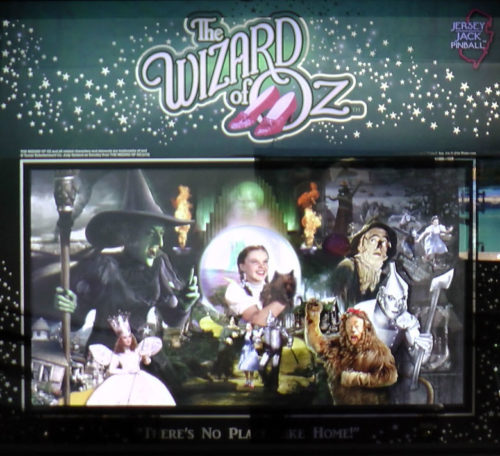 Wow! What a light show! The machine before you represents the first offering from the fledgling company of Jersey Jack Pinball of Lakewood, N.J. A pinball of any production hasn’t been made in the state for decades. This machine was created as a centerpiece of technology to show the arcade world what a contemporary machine can contain in one package. Stern, the only other U.S. maker of pinball, has always streamlined the process of pinball manufacturing and kept the number of pinball “toys” on a machine to a minimum to make their machines less expensive. Since this machine came out, Stern now offers three models of their newer machines: a stripped basic unit, an average machine contents wise and a tricked-out collectable unit to compete with the likes of Jersey Jack. Look at this machine! Mike Balcer designed the playfield; Jerry Vandersteldt, Greg Freres and Matt Riesterer penned the artwork. 1,000 units are already spoken for and both a special edition (the one here) and a standard edition are planned. Five flippers, five magnets, color changing LEDs, a 26-inch LED monitor, shaker motor, ball lift, spinning house toy, crystal ball projector, rising witch and wide-body package are only some of the innovations seen here.
Wow! What a light show! The machine before you represents the first offering from the fledgling company of Jersey Jack Pinball of Lakewood, N.J. A pinball of any production hasn’t been made in the state for decades. This machine was created as a centerpiece of technology to show the arcade world what a contemporary machine can contain in one package. Stern, the only other U.S. maker of pinball, has always streamlined the process of pinball manufacturing and kept the number of pinball “toys” on a machine to a minimum to make their machines less expensive. Since this machine came out, Stern now offers three models of their newer machines: a stripped basic unit, an average machine contents wise and a tricked-out collectable unit to compete with the likes of Jersey Jack. Look at this machine! Mike Balcer designed the playfield; Jerry Vandersteldt, Greg Freres and Matt Riesterer penned the artwork. 1,000 units are already spoken for and both a special edition (the one here) and a standard edition are planned. Five flippers, five magnets, color changing LEDs, a 26-inch LED monitor, shaker motor, ball lift, spinning house toy, crystal ball projector, rising witch and wide-body package are only some of the innovations seen here. -
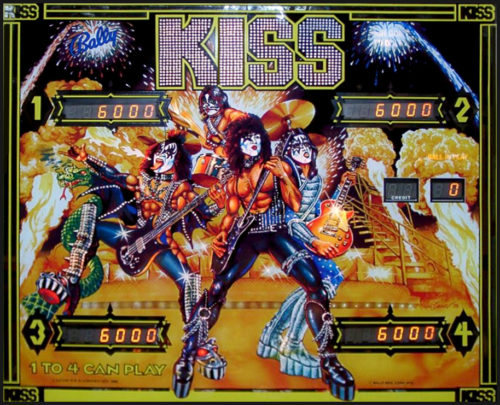
-
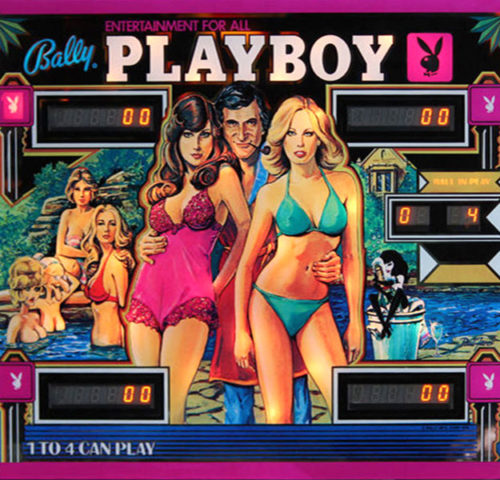 This solid-state game was very popular when it was released and has a lot of smooth shots to complete. It was designed by Jim Patla with artwork by Paul Faris. Production run was 18,250 units. This pre-speaking pinball has Hugh Hefner on its backglass with Bunny Sondra Theodore posing. At the top of the game are four rollover lanes, which advance when hit to a special and advance the bonuses and grotto award. Hitting the five Bunny targets also advance a feature to win extra balls and specials. A unique kickback lane advances with every entrance into it. A five-pack of drop targets also advance certain features on the game. If 20,000 points are made on the bonus system, this point count is carried over to all remaining balls and then some. The nicest shot on the game is going up the right side from the flipper and looping the ball into the grotto. The sound originates from the old TV show “Playboy After Dark.”
This solid-state game was very popular when it was released and has a lot of smooth shots to complete. It was designed by Jim Patla with artwork by Paul Faris. Production run was 18,250 units. This pre-speaking pinball has Hugh Hefner on its backglass with Bunny Sondra Theodore posing. At the top of the game are four rollover lanes, which advance when hit to a special and advance the bonuses and grotto award. Hitting the five Bunny targets also advance a feature to win extra balls and specials. A unique kickback lane advances with every entrance into it. A five-pack of drop targets also advance certain features on the game. If 20,000 points are made on the bonus system, this point count is carried over to all remaining balls and then some. The nicest shot on the game is going up the right side from the flipper and looping the ball into the grotto. The sound originates from the old TV show “Playboy After Dark.” -
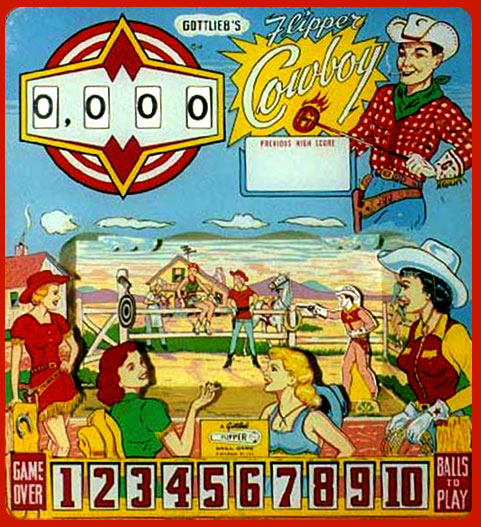 This Gottlieb game is one of the five in the museum of the “flipper” series from Gottlieb. These games are all add-a-ball games. The layout of this game parallels a future Gottlieb classic by the name of “Buckaroo” (also in the museum). 1,550 of these machines were manufactured. Wayne Neyens designed the game and Roy Parker established the art package. Fifteen targets on the roto-target are present and spinning the roto would bring up new numbers to complete. If you are skillful enough to sequence four numbers in a row, an extra ball is awarded. The bull’s-eye target awards an extra ball also. Each time an extra ball is awarded, the backglass animation activates. The cowboy shoots at the targets, which causes them to spin. No match feature here and tilting the game forfeits the ball in play as well as a future ball in play.
This Gottlieb game is one of the five in the museum of the “flipper” series from Gottlieb. These games are all add-a-ball games. The layout of this game parallels a future Gottlieb classic by the name of “Buckaroo” (also in the museum). 1,550 of these machines were manufactured. Wayne Neyens designed the game and Roy Parker established the art package. Fifteen targets on the roto-target are present and spinning the roto would bring up new numbers to complete. If you are skillful enough to sequence four numbers in a row, an extra ball is awarded. The bull’s-eye target awards an extra ball also. Each time an extra ball is awarded, the backglass animation activates. The cowboy shoots at the targets, which causes them to spin. No match feature here and tilting the game forfeits the ball in play as well as a future ball in play. -
 This machine was produced in january and 7300 copies of it were bolted together. Pat lawlor designed the game with john youssi penning the artwork. The earliest machines in the production run had the chicago cubs logo on the child’s baseball cap but the cubs disallowed its use so the logo was changed. The early examples had a williams logo sticker over the cubs logo. The object of the game is to advance the compass to the north, south , east and west positions. Doing so starts ball lock ..And the “power of the wind” through the use of a dedicated fan on top of the machine to recreate a new physical dimension to your gameplay. Once three balls are locked, the left ramp awards increasing million awards. By earning enough tolls, extra balls may be had. The super cellar value changes via the spinner. Dropping into the cellar awards its value. Another “twist“ in the game’s design is the spinning discs. Tornado action.
This machine was produced in january and 7300 copies of it were bolted together. Pat lawlor designed the game with john youssi penning the artwork. The earliest machines in the production run had the chicago cubs logo on the child’s baseball cap but the cubs disallowed its use so the logo was changed. The early examples had a williams logo sticker over the cubs logo. The object of the game is to advance the compass to the north, south , east and west positions. Doing so starts ball lock ..And the “power of the wind” through the use of a dedicated fan on top of the machine to recreate a new physical dimension to your gameplay. Once three balls are locked, the left ramp awards increasing million awards. By earning enough tolls, extra balls may be had. The super cellar value changes via the spinner. Dropping into the cellar awards its value. Another “twist“ in the game’s design is the spinning discs. Tornado action.